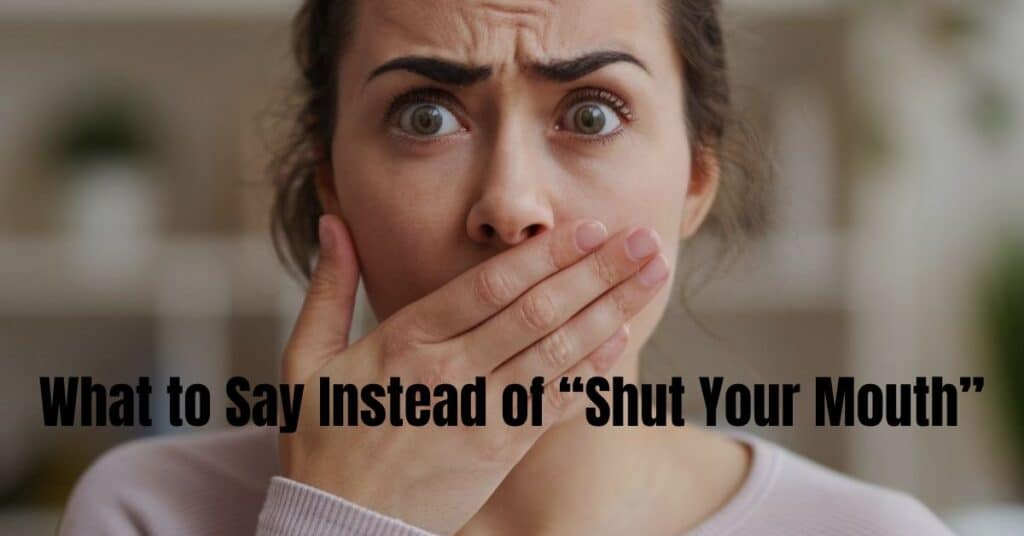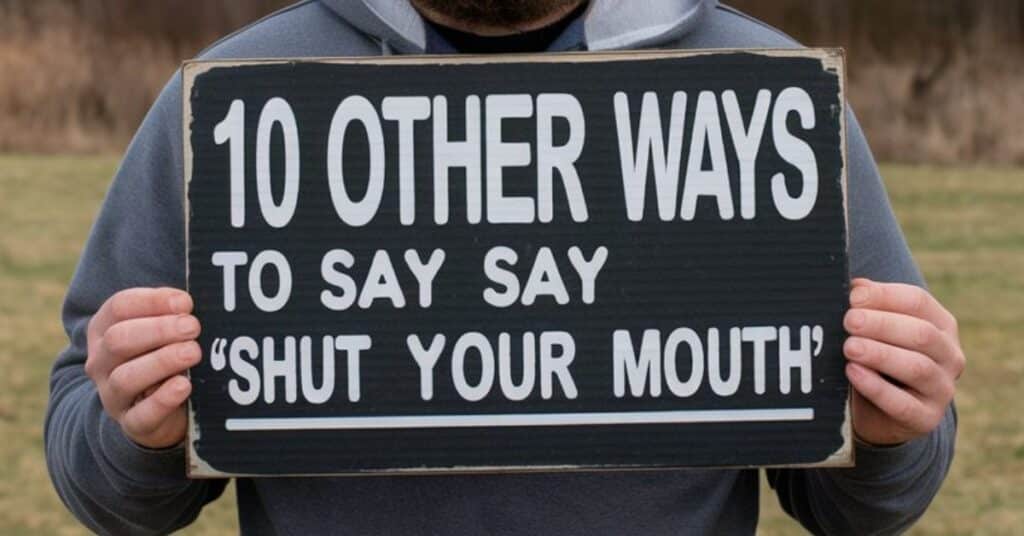In certain situations, asking someone to be quiet without sounding rude can be tricky. Whether you’re in a meeting, a heated debate, or just chatting casually, you need a tactful way to convey your message.
This guide explores ten alternatives to the phrase “shut your mouth.” We’ll provide real-world examples to help you understand when and how to use these phrases effectively, ensuring that you get your point across without offending the listener.
What to Say Instead of “Shut Your Mouth”

Here are ten respectful yet clear alternatives:
- Keep it down.
- Zip it.
- Button up.
- Hold your tongue.
- Hush up.
- Silence yourself.
- Put a sock in it.
- Cut the chatter.
- Clamp it shut.
- Stop talking.
1. Zip it (Informal)Better than saying shut your mouth
“Zip it” is an informal, direct way to tell someone to stop talking. It’s short, visual, and often used when you need someone to be quiet quickly. However, it’s best reserved for casual settings or among friends, as it can come across as blunt in professional situations.
Usage examples:
- “Zip it, kid! Mom’s right there, and she’ll hear you!”
- “Alright, class, zip it! Time to focus.”
READ THIS BLOG ALSO :10 Other Ways to Say “In My Opinion” (With Examples)
2. Hold Your Tongue (Formal)
A more formal and old-fashioned way to request silence, “hold your tongue” implies that the person should refrain from saying something inappropriate. It’s commonly used in professional or delicate social situations where tact is needed.
Usage examples:
- “Hold your tongue, sir! Your words are verging on disrespect.”
- “Hold your tongue, dear, it’s rude to speak ill of someone’s cooking.”
3. Put a Sock in It (Very Informal)
This phrase is highly informal and often used in comedic or exaggerated scenarios. It suggests an absurd visual of silencing someone by stuffing a sock in their mouth. Best used in casual contexts, it’s a fun, albeit forceful, way to tell someone to stop talking.
Usage examples:
- “Put a sock in it, I’ve had enough of your whining!”
- “Put a sock in it, everyone! Let’s focus on the task.”
4. Is Silence Yourself (Formal) is better than saying shut your mouth?
“Silence yourself” is a commanding phrase that places responsibility on the listener to manage their speech. It’s often used in professional or formal settings when authority needs to be asserted.
Usage examples:
- “Mr. Smith, silence yourself and let the other speaker respond.”
- “During meditation, learn to silence yourself, both mentally and physically.”
5. Cut the Chatter (Semi-Formal)
A semi-formal way to ask a group to stop unnecessary conversation, “cut the chatter” is often used in workplace or classroom settings. It implies that the ongoing talk is not important and distracts from the task at hand.
Usage examples:
- “Alright, team, cut the chatter. We’ve got work to do.”
- “Please cut the chatter, this is a study area.”
6. shut your mouth or Hush Up (Informal)
“Hush up” is a gentler, informal way to quiet someone down. It’s often used when you need someone to lower their voice, particularly when maintaining peace is key, like with children or family gatherings.
Usage examples:
- “Hush up, everyone, the surprise is coming!”
- “Hush up, little ones, it’s story time.”
7. Button Up (Semi-Formal)
“Button up” is a memorable and semi-formal phrase, evoking the image of closing your mouth like buttoning a coat. It’s less aggressive and can be used in professional and social situations where a more polite tone is needed.
Usage examples:
- “Button up about the project; we don’t want leaks.”
- “Button up, please. The meeting is about to begin.”
8. Clamp It Shut (Informal)
“Clamp it shut” is a forceful and informal way to demand silence, often used when frustration has peaked. It’s more appropriate in casual settings, as its aggressive tone can come across as rude in professional environments.
Usage examples:
- “Clamp it shut, or I’ll start sharing your embarrassing stories!”
- “Clamp it shut, guys! Less talking, more working.”
9. Stop Talking (Direct)
The most straightforward and unambiguous way to ask for silence, “stop talking” leaves no room for interpretation. It can be used in various contexts but may come off as harsh if not softened with a “please” or explanation.
Usage examples:
- “Stop talking, I need full focus on this!”
- “Stop talking now. The exam is starting.”
10. Silence Yourself (Formal)
This phrase, which places emphasis on self-control, is best used in formal settings. It’s particularly effective when used by people in authority, like judges, moderators, or teachers.
Usage examples:
- “Silence yourself, counselor, or I’ll hold you in contempt.”
- “During our retreat, we practice silencing ourselves, both internally and externally.”
By using these alternatives, you can navigate tricky social situations more tactfully while still getting your point across.
Frequently Asked Questions
When should I use “Zip it” versus “Hold your tongue”?
“Zip it” is informal and works well in casual conversations among friends or in light-hearted situations. On the other hand, “Hold your tongue” is more formal and should be used in situations requiring tact or when addressing someone in a professional or delicate context.
Is “Put a sock in it” considered rude?
Yes, “Put a sock in it” can come off as rude, especially if used in formal or professional settings. It’s best suited for casual situations among close friends or when used humorously.
What’s the difference between “Silence yourself” and “Stop talking”?
“Silence yourself” is a formal and authoritative phrase, often used in professional or structured environments. “Stop talking,” while equally direct, is more neutral and can be used in a wider range of situations. However, it may sound blunt if not softened with a polite tone.
Can I use “Cut the chatter” in a professional meeting?
Yes, “Cut the chatter” is semi-formal and can be effectively used in professional settings, especially in team meetings or group discussions where side conversations are causing distractions.
Is “Button up” a polite phrase?
“Button up” is semi-formal and can be considered polite when used with the right tone. It’s less harsh than other alternatives and adds a bit of charm, making it suitable for professional or social interactions where maintaining a positive relationship is important.
Conclusion
Choosing the right words to ask someone to be quiet can make a significant difference in how your message is received. Whether you’re in a formal meeting, a casual conversation, or a situation requiring immediate silence, the ten alternatives to “shut your mouth” we’ve explored offer a range of options. From direct commands like “Stop talking” to more playful phrases like “Put a sock in it,” each has its unique tone and context.
By using these alternatives thoughtfully, you’ll be able to communicate effectively without causing unnecessary tension or offense. Remember, the key to getting your message across lies not just in what you say, but in how you say it.

“Robert Henry is an experienced blogger with a passion for language and education. His insightful posts on Vocab Scope offer readers valuable tips on vocabulary and grammar. With a background in linguistics and a knack for clear, engaging writing, Robert is dedicated to helping others enhance their communication skills.”






